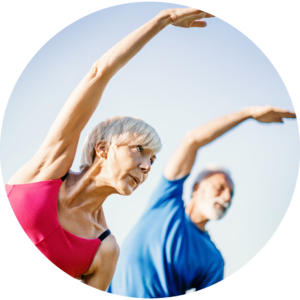Exercise and Parkinson’s
Significant research studies and anecdotal evidence highlight the critical importance of exercise for people with Parkinson’s. Regular physical exercise can improve mobility and coordination, boost your mood, reduce stiffness, and minimize soreness and fatigue. And each year, more studies prove that exercise may slow the progression of Parkinson’s itself. Multiple studies explore the possibility that exercise helps protect nerve cells at risk of damage, degeneration, or cell death. In other words, the most vulnerable cells are strengthened before they experience damage – thanks to exercise.
In this collection of resources, we share information about the many ways exercise is medicine for Parkinson’s, plus what to do if you’re not sure what type of exercise is best for you, you don’t feel like exercising, you need to find a Parkinson’s physical therapist in your area, exercise hurts, you need a plan that’s doable and sustainable, and much more.
Click here to explore more Parkinson’s Topics.

How Important Is Exercise to People Living with Parkinson’s?
Exercise not only improves your general health, but it also has specific physical, mental, and emotional benefits. In this post, we help you explore how to add more movement into your daily routine as you learn the many benefits of exercise for people with Parkinson’s.
Why Exercise is Medicine for the Brain
In 2003, on a bike ride with a friend, Dr. Jay Alberts noticed something that would go on to shape the next two decades of his life. During the multi-day, group ride across Iowa (RAGBRAI), Dr. Alberts pedaled a tandem bike with a friend with Parkinson’s and noticed that after a few days, his friend’s handwriting dramatically improved. “Turns out it was riding the tandem that was making the difference,” he said. Since this discovery, Dr. Alberts and his colleagues have dedicated 17 years to studying the effects of exercise on Parkinson’s symptoms. Their research continually supports the belief that forced and high-intensity aerobic exercise improves motor function (and more) in people with Parkinson’s. In this video, Dr. Alberts explains how exercise is medicine for the brain.
Staying on Track with Your Exercise Routine
Even knowing how powerful a tool exercise is for living well with Parkinson’s every day, staying on track and making exercise part of your daily routine can be difficult. Maybe you haven’t been a regular exerciser. Maybe you have been dealing with pain, motor symptoms, trouble sleeping, fatigue, declining mobility, and depression for many years. And exercise can be challenging. Sure, there are those among us who love to push themselves and face the challenge and the grind of exercising every day, but not all of us do. So, now what? If you don’t gravitate toward regular exercise or feel well enough to do it, this article offers suggestions to help you get started and stick with it.
Cycling and Parkinson’s: What We Know (and Are Learning) So Far
While we’d never say cycling helps everyone with Parkinson’s or that it is an exercise you must do if you want to live well with Parkinson’s, research studies have shown that many people have experienced significant benefits from pushing pedals on a regular basis. Depending upon pace and intensity, cycling has been shown to improve overall motor function, reduce tremor, reduce bradykinesia, reduce rigidity, improve aerobic capacity, improve mood, improve cognitive function, increase joy and social connection, and decrease UPDRS scores (Unified Parkinson’s Disease Rating Scale). Check out our timeline for the latest in Parkinson’s cycling research, living well stories, and more.
Explore More Resources About Exercise and Parkinson's
Additional Videos
- The Science of Intense Exercise
- How to Exercise to Get Results from Parkinson’s Exercise Programs
- YOPD Council: Exercise, Community, and Parkinson’s
- Exercising Your Body and Mind: Tai Chi for Parkinson’s
- The Latest and Greatest on Boxing and Parkinson’s
- Exercise to Live Well with Parkinson’s
- Living Well with Parkinson’s through Dance and Movement
- What Role Does Exercise Play in Managing Parkinson’s Symptoms?
- Creating the Right Exercise Plan for Parkinson’s
- Ask the Parkinson’s Expert: Cognitive and Emotional Benefits of Exercise with Davis Phinney
- Ask the Parkinson’s Expert: Pain and Exercise with Davis Phinney
- Ask the Parkinson’s Expert: All about Bikes with Davis Phinney
- Punching Back at Parkinson’s with Exercise
- Tracking Exercise Progress Over Time with Parkinson’s
- Camping with Parkinson’s: Exercise and Nutrition
- Managing Parkinson’s with the Mind of a Dancer
- Movement Break – Balance, Strength, and Endurance with Jimmy Choi
- Movement Break: Tai Chi
- Movement Break: Move BIG!
- Movement Break: Dance for PD®
- Movement Break: Dynamic Mobility
- Movement Break – Rock Steady Boxing
- Move It! Exercise and Physical Activity are Key to Living Well with Parkinson’s
- 2018 Davis Phinney Foundation-funded Research Studies Continues to Push the Pedals on Living Well with Parkinson’s Today
- Moments of Victory® – Tom Sheppard Slows Parkinson’s Progression with Intense Exercise
- 10 Tips for Exercising with Parkinson’s
- How to Encourage People with Parkinson’s to Exercise
- How to Increase Exercise Sustainment while Living with Parkinson’s
- How to Exercise & Live Better with Parkinson’s with Dr. Jay Alberts
- Exercise Is Medicine for the Brain
- Moments of Victory® – “Art in Motion” Helps a Dallas Community Live Well with Parkinson’s
- 2016 Tai Chi Study Funded by the Davis Phinney Foundation Continues to Help People Live Well with Parkinson’s
- High-Intensity Exercise Helps Slow the Progression of Parkinson’s
- Funded research study will explore exercise, advanced Parkinson’s, and DBS
- Keep ON Moving with a New Online Parkinson’s Exercise Program
- How a Bicycle Ride Led to Ground-Breaking Parkinson’s Research
- Moments of Victory® – Zach Guza Knows the Power of Exercise in Living Well with Parkinson’s
- How Can Boxing Help You Live Well with Parkinson’s?
- Community-Based Cycling Class for Slowing Disease Progression
- Moments of Victory® – Judith Wilson Pedals for Parkinson’s
- What You Need to Know about Cycling with Parkinson’s
- Dance for Parkinson’s: More than Just Exercise
- Brain Training: Effects of Aerobic Exercise in Parkinson’s Disease
- 4-Part Core Strengthening Series for Parkinson’s
- How Exercise Can Ease Anxiety in Parkinson’s
- Moments of Victory® – Jon Lessin Dreams Bigger because of Parkinson’s
- 4 Reasons Your Parkinson’s Symptoms May Be Worse after Exercise
- Moments of Victory® – Kerry Boxes with Parkinson’s
- Your Aerobic Exercise Prescription
- How an eBike Can Bring New Life to Your Life
- Everything You Ever Wanted to Know about eBikes for People with Parkinson’s… and More
- How Intense Exercise Changed my Life with Parkinson’s
- Stepping Out of the Research Lab and Spinning into Real Life
- What Cycling Options Do I Have When Balance and Space Are an Issue?
- Moments of Victory® – Pete Huley Keeps On Moving with a Little Help from Team DPF
- A Timeline of Jay Alberts’ Parkinson’s Research
- Tour de Victory Rides through Boulder
- Exercising Safely with Parkinson’s and nOH
- Kevin Schmid on Why “Every Victory Counts”
- Cycling and Parkinson’s: The Long Climb Back from COVID-19
- Kristin Vannorsdel Rides for Her Mom
- How to Become “an Exerciser”
- Moments of Victory – John Davis Rides Everesting
- “I Rode the Rockies While Living Well with Parkinson’s”
- How Sarcopenia Affects Quality of Life with Parkinson’s
- Team DPF Member Jon Dittmer Rides the Parkinson’s Peloton
- A Day in the Life of a Parkinson’s Ambassador: Patti Burnett
- How to Exercise to Improve Parkinson’s Symptoms
Connect with an Ambassador
Our Ambassadors connect with individuals and families looking for support and community to help them live well with Parkinson’s. Ambassadors are available to speak with you through email, phone, video conference, and in-person.
 Marty Acevedo
Marty AcevedoOceanside, California
 Edie Anderson
Edie AndersonVenice, Florida
 Veronica M Arevalo
Veronica M ArevaloBakersfield, California
 Carol Boase
Carol BoaseDayton, Ohio
 Drew Burke
Drew BurkeGeorgia
 Cynthia Camp
Cynthia CampAsheville, North Carolina
 Amy Carlson
Amy CarlsonMonrovia, California
 Deb Colling
Deb CollingBerkley, Michigan
 Tom Cosentino
Tom CosentinoOcean View, Delaware
 Chris Daigre
Chris DaigreSeattle, Washington
 Pam Daniger
Pam DanigerGranada Hills, California
 Jane Davis
Jane DavisDenver, Colorado
 Pat Donahoo
Pat DonahooLas Vegas, Nevada
 Joan Emerson
Joan EmersonBiddeford, Maine
 Michael Fahning
Michael FahningChaska, Minnesota
 Julie Fitzgerald
Julie FitzgeraldAustin, Texas
 Gail Gitin
Gail GitinBoulder, Colorado
 Shan Havins
Shan HavinsIdaho Falls, Idaho
 Kerry Howard
Kerry HowardJuneau, Alaska
 Rick Johnston
Rick JohnstonWestlake, Louisiana
 Charlotte Juarez
Charlotte JuarezKingwood, Texas
 Kris Kimball
Kris KimballArvada, Colorado
 Teri Lamers
Teri LamersMinneapolis, Minnesota
Kristi LaMonica
Troy, New York
 Danna Lee
Danna LeeNaperville, Illinois
 Stan Livingston
Stan LivingstonMadison, Wisconsin
 Barb Matheny
Barb MathenyFindlay, Ohio
 Kristin McCoach
Kristin McCoachDoylestown, Pennsylvania
 Kristine Meldrum
Kristine MeldrumWest Des Moines, Iowa
 Wendy Miller
Wendy MillerBellingham, Washington
 Chanda Morra
Chanda MorraBoynton Beach, Florida
 Laura Olmos
Laura OlmosLaredo, Texas
 Sylvie Parent
Sylvie ParentCollingwood, Ontario, Canada
 Doug Pickard
Doug PickardParksville, British Columbia
 Helen Power
Helen PowerFelton, California
 Steve Quam
Steve QuamAnderson, South Carolina
 Eric Rappaport
Eric RappaportCary, North Carolina
 David Rathgeber
David RathgeberFallbrook, California
 Terry Reed
Terry ReedMorrison, Colorado
 Doug Reid
Doug ReidLafayette, Colorado
 Gregory B. Ritscher
Gregory B. RitscherPanama City Beach, Florida
 Kristin S.
Kristin S.Cambridge, Massachusetts
 Kevin Schmid
Kevin SchmidGreat Falls, Montana
Carol Schram
Washington, Michigan
 Julie Sharber
Julie SharberEvergreen, Colorado
 Stephanie Soto
Stephanie SotoSaratoga Springs, New York
 Spencer Stucki
Spencer StuckiChubbuck, Idaho
 John Sullivan
John SullivanHull, Massachusetts
 Lisa Tiger
Lisa TigerSanta Fe, New Mexico and Eastern Oklahoma
 Dennis Tinley
Dennis TinleyBrielle, New Jersey
 Mayra Torres
Mayra TorresPhoenix, Arizona
 Sherry Vigliotti
Sherry VigliottiEast Patchoque, New York
 Sandy Webb
Sandy WebbKailua Kona, Hawaii
 Bette Willins
Bette WillinsTuxedo, New York





